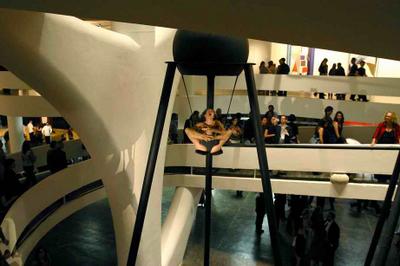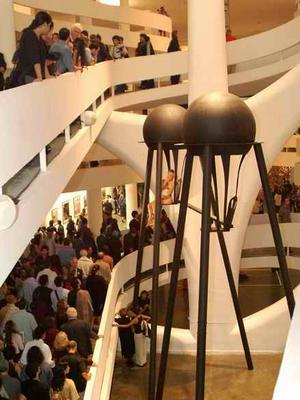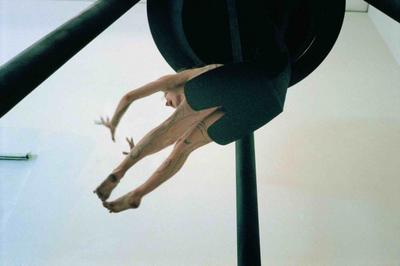|
|---|
Wednesday, October 19, 2005
 Today's viewing of the film Comer o Coração de Rui Chafes e Vera Mantero by Inês Oliveira (during the DocLisboa documentary film festival) made me go back to the original piece of art by the unusual duo - dancer Vera Mantero and sculptor Rui Chafes.
Today's viewing of the film Comer o Coração de Rui Chafes e Vera Mantero by Inês Oliveira (during the DocLisboa documentary film festival) made me go back to the original piece of art by the unusual duo - dancer Vera Mantero and sculptor Rui Chafes.
I must admit the work - called Eating Your Heart Out - struck me instantly as somewhat pretentious, pompous even in its post-expressionist "wild and true" attitude. Here is why: what you get is really a combination of two hermetic worlds. One is the hard-core line of modern (neo-modernist, I would dare say) sculpture. The other is the no less esoteric work of contemporary dance, one that still hangs on the "interior truth" ideals (the truth is within you, be true to yourself, etc.), but takes it to another level, accepting anything that's visceral, be it African shamanism, Bali ritual or Indian grotesque face-making. (You could call it post-modernism at its most obvious, if you wish. I'd rather not, since calling something post-modernism just because it includes elements from different epochs and places seems naive, considering similar procedures in the rest of art history.)
Combine the two and you get... well, what exactly do you get? A combination of the two. Does it mix? And does oil mix with water? Of course it does - creating a specific design, a dance unique for this combination.
The problem I found with it was that it was extremely hermetic. Someone I know who worked on the production of the piece told me it was quite different at the Sao Paolo Biennale, where visitors could see it from all levels. Thus, you could be right next to Mantero during her performance, or above or below her. The variation of point of view allowed a true visiting of the work.
In Lisbon, at the CCB, all we got was a view from the bottom.
Obviously, a large sculpture always has this sort of limitations. Here, though, we found ourselves deep in the pit, far from the heart, whether it was "eaten" or "vomited". (1) You face a huge metal sculpture, with a tiny little person up there, moving, screaming, singing, whistling - but all this seemed, well, almost symbolic, not direct, not present enough. Problems with distance scare me, as they seem at once subjective and difficult to surmount. A couple of glasses of wine, maybe?
Something else struck me in the documentary, though. The film is a fairly simple following of the piece's evolution. And what we see, is how the process of mythologizing art comes to being. How
matter turns into narrative, turns into object, movement, symbol, how content is transfered into the "as if" zone, or the "suspended disbelief" zone. Only through discovering the process did the work gain weight for me. Which is a common paradox of much of modern art: the artist abandons you. She has a key, but she decides you are to find your own key. And it is probably because of my laziness, but I simply usually don't feel like making the effort. It seems less... fun (?) to make up my own possible stories than to discover that the idea came from a balloon, from the idea of suspension, and from the idea of an eye, and of a being, a strange being. I can still make my own story, but learning about the roots gives me more momentum when I embark on the voyage.
In the work itself, the balloon has long disappeared. I am left with a ball, a dot. Closed into itself, the art-ist lives herself out, and her art - the wonderful discovery of the inner self.
But that implies that I am already a believer (in our cynical times!). That I believe in the self as strictly inner. And, for that matter, as a true self. And, of course, that I believe in wonders.
Which, to me, is a fair definition of hermetic art.
What is shared in the artistic expreience? Notice - it seems to be the artist's experience, but it is usually described as if it were the viewer's experience. No wonder sharing is so difficult. This is confusing empathy with confusion.
It is a strong piece of work. Both artists know their crafts, they know their references. They know how to build a structure of references. Nonetheless, references aren't always enough to integrate. Not enough to create a world. Especially, when the artists think of themselves as discoverers of new territories. As combiners, joiners. Balance and rooting seem key here. They are both very delicate issues: one has to do with the specific dynamics of each area of arts, they other, with the way one uses what came before. The balance seemed wrong here - the language of fine arts, with its silent phrases and comfortably clean lines, ate the heart out of the performance. Vera Mantero became a small, funnily painted strange creature, suspended too high. At least too high for me.
(1)Vera Mantero mentions (link to Portuguese site) she doesn't really identify with the title, as she is rather "vomiting than eating" the heart. She considers her performance to be an "answer to the title". Another strange thing about the title is that in English, it is Eating Your Heart Out. The Portuguese title would literally mean "to eat the heart". It comes from a sentence by Musil that Rui Chafes mentions in an interview (link to Portuguese site): "it is necessary to eat one's mother's heart [out? - vv.] to understand the language of birds".
Labels: film, performing, Portugal, sculpture













